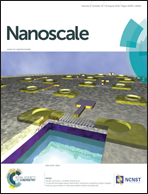Bespoke contrast-matched diblock copolymer nanoparticles enable the rational design of highly transparent Pickering double emulsions†
Abstract
We report the preparation of highly transparent oil-in-water Pickering emulsions using contrast-matched organic nanoparticles. This is achieved via addition of judicious amounts of either sucrose or glycerol to an aqueous dispersion of poly(glycerol monomethacrylate)56–poly(2,2,2-trifluoroethyl methacrylate)500 [PGMA–PTFEMA] diblock copolymer nanoparticles prior to high shear homogenization with an equal volume of n-dodecane. The resulting Pickering emulsions comprise polydisperse n-dodecane droplets of 20–100 μm diameter and exhibit up to 96% transmittance across the visible spectrum. In contrast, control experiments using non-contrast-matched poly(glycerol monomethacrylate)56–poly(benzyl methacrylate)300 [PGMA56–PBzMA300] diblock copolymer nanoparticles as a Pickering emulsifier only produced conventional highly turbid emulsions. Thus contrast-matching of the two immiscible phases is a necessary but not sufficient condition for the preparation of highly transparent Pickering emulsions: it is essential to use isorefractive nanoparticles in order to minimize light scattering. Furthermore, highly transparent oil-in-water-in-oil Pickering double emulsions can be obtained by homogenizing the contrast-matched oil-in-water Pickering emulsion prepared using the PGMA56–PTFEMA500 nanoparticles with a contrast-matched dispersion of hydrophobic poly(lauryl methacrylate)39–poly(2,2,2-trifluoroethyl methacrylate)800 [PLMA39–PTFEMA800] diblock copolymer nanoparticles in n-dodecane. Finally, we show that an isorefractive oil-in-water Pickering emulsion enables fluorescence spectroscopy to be used to monitor the transport of water-insoluble small molecules (pyrene and benzophenone) between n-dodecane droplets. Such transport is significantly less efficient than that observed for the equivalent isorefractive surfactant-stabilized emulsion. Conventional turbid emulsions do not enable such a comparison to be made because the intense light scattering leads to substantial spectral attenuation.


 Please wait while we load your content...
Please wait while we load your content...